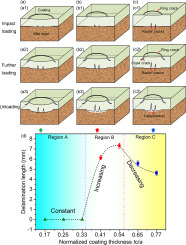Surface & Coatings Technology ( IF 5.3 ) Pub Date : 2020-03-19 , DOI: 10.1016/j.surfcoat.2020.125650 H. Guo , N.C. Wu , Y.L. Zhang , S.D. Zhang , W.H. Sun , J.Q. Wang

|
The impact behavior of Fe-based amorphous coatings with various thicknesses fabricated by high-velocity-air-fuel thermal spraying was systematically investigated via 3D X-ray tomography. The results showed that the impact damage occurred principally by cracking in the coating, plastic deformation in the substrate, and delamination at the coating/substrate interface. It was found that the size of the interfacial delamination was a nonlinear function of the normalized coating thickness tc/a (i.e. the ratio of coating thickness (tc) to the contact radius (a)). Three thickness regions of distinctive damage modes were identified: thin coating region (tc/a ≤ 0.33), intermediate-thickness region (0.33 < tc/a ≤ 0.54), and thick coating region (tc/a > 0.54). For tc/a ≤ 0.33, no delamination appeared in the coating/substrate interface. With an increase from tc/a = 0.33 to tc/a = 0.54, the extent of interfacial delamination increased quickly and reached a maximum. Finally, when tc/a > 0.54, the extent of delamination decreased when tc/a increased. In addition, it was indicated that the residual stress was found to decrease with the coating thickness, reflecting that the residual stress was excluded as a predominant factor of impact damage. Furthermore, a good agreement with the Hertz impact theory and finite element modeling was identified in the case of interfacial damage: significant delamination was observed in the 600 μm coating when the maximum shear stress occurred close to the coating/substrate interface. This finding can be used to assist the design of coated components in load-bearing applications.
中文翻译:

涂层厚度对铁基非晶态涂层冲击破坏模式的影响
通过3D X射线断层扫描系统研究了通过高速空气燃料热喷涂制备的各种厚度的铁基非晶涂层的冲击行为。结果表明,冲击损伤的发生主要是由于涂层开裂,基材的塑性变形以及涂层/基材界面的分层。发现界面分层的大小是归一化涂层厚度t c / a(即涂层厚度(t c)与接触半径(a)之比)的非线性函数。确定了三种不同破坏模式的厚度区域:薄涂层区域(t c / a ≤0.33),中间厚度区域(0.33 < 吨Ç /一个 ≤0.54),和厚的涂层区域(吨ç /一 > 0.54)。对于吨Ç /一个 ≤0.33,无分层出现在涂层/基材界面。从t c / a = 0.33增加到t c / a = 0.54,界面分层的程度迅速增加并达到最大值。最后,当t c / a > 0.54时,当t c / a时分层的程度降低增加。另外,表明发现残余应力随着涂层厚度的降低而降低,这反映出残余应力被排除为冲击损伤的主要因素。此外,在界面损伤的情况下,与赫兹冲击理论和有限元建模也得到了很好的一致:当最大剪切应力发生在涂层/基材界面附近时,在600μm涂层中观察到了明显的分层。该发现可用于辅助承重应用中涂层部件的设计。











































 京公网安备 11010802027423号
京公网安备 11010802027423号